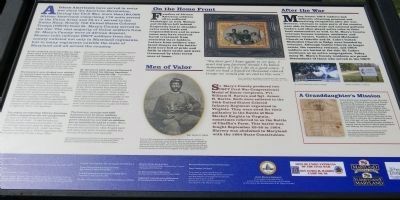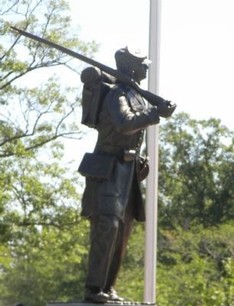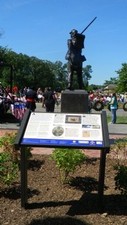Lexington Park United States Colored Troops Civil War Memorial Monument
Introduction
Text-to-speech Audio
This monument honors African American soldiers who served in the Civil War as part of the United States Colored Troops (USCT). The memorial was erected in 2012 by the Unified Committee for Afro-American Contributions (UCAC) and James H. Harris Camp, Sons of Union Veterans of the Civil War.
Images
Photo taken by Richard E. Miller

Photo taken by Richard E. Miller

Photo taken by Richard E. Miller

Backstory and Context
Text-to-speech Audio
The monument honors the 29,000 sailors and 180,000 soldiers who who served in the Union navy and army. Nearly seven hundred African American men from St. Mary’s County served in these units during the last two years of the war after Abraham Lincoln authorized the creation of all-Black regiments. Prior to 1863, African Americans were barred from military service in the Union. The Confederacy authorized a small number of Black regiments in the final days of the war but their reliance on slavery was incompatible with Black military service
The vast majority of men who served in the Union army from St. Mary’s County were of African descent. Muster rolls indicate that these men served in a number of regiments across the country.
White Maryland residents had divided loyalties at the outset of the war and some white landowners supported secession. For the most part, whites in this and other southern Maryland communities were aligned with the South. After Lincoln authorized Black military service as part of the Emancipation Proclamation, African Americans saw military service as a way to hasten the end of slavery.
Lincoln did not act alone. Prominent Black leaders including Frederic Douglass and Robert Smalls led efforts to petition the federal government and helped to convince Lincoln and other Northern leaders to change the military's policy of exclusion. In July of 1862, for example, Congress passed the Militia Act of 1862. Over time, Black leaders demonstrated that it had become an “indispensable military necessity” to call on African American men to help save the Union. On September 27, 1862, the first Black regiment was formed even if it was not officially recognized by the Union Army. After January 1, 1863, when the Emancipation Proclamation was issued, the War Department authorized the recruiting of African American soldiers. Recruitment efforts intensified and slave owners in states that had not joined the Confederacy were offered monetary compensation for releasing enslaved men so that they might enlist.
By the end of 1863, General Ulysses S. Grant viewed the African American soldier as a “powerful ally.” President Lincoln made it clear to military authorities and citizens alike that African American soldiers were to be accorded the rights and privileges of bearing arms in support of the Union Army. Both freemen and former slaves joined the fight. In spite of harsh conditions and inadequate supplies, these soldiers went on to participate in some of the most important battles of the war. African Americans proved themselves as reputable soldiers many times over, yet discrimination in pay and other areas remained widespread.
After the war, many African Americans had difficulties obtaining soldiers' pensions and receiving the recognition afforded to white veterans. However, many Black veterans were able to become ministers, educators, and entrepreneurs.
Idolia Shubrooks led the effort to make this memorial a reality, working for more than 20 years to conduct research, garner support among others, and raise funds. Her journey began when she found her Grandfather's muster papers.
The vast majority of men who served in the Union army from St. Mary’s County were of African descent. Muster rolls indicate that these men served in a number of regiments across the country.
White Maryland residents had divided loyalties at the outset of the war and some white landowners supported secession. For the most part, whites in this and other southern Maryland communities were aligned with the South. After Lincoln authorized Black military service as part of the Emancipation Proclamation, African Americans saw military service as a way to hasten the end of slavery.
Lincoln did not act alone. Prominent Black leaders including Frederic Douglass and Robert Smalls led efforts to petition the federal government and helped to convince Lincoln and other Northern leaders to change the military's policy of exclusion. In July of 1862, for example, Congress passed the Militia Act of 1862. Over time, Black leaders demonstrated that it had become an “indispensable military necessity” to call on African American men to help save the Union. On September 27, 1862, the first Black regiment was formed even if it was not officially recognized by the Union Army. After January 1, 1863, when the Emancipation Proclamation was issued, the War Department authorized the recruiting of African American soldiers. Recruitment efforts intensified and slave owners in states that had not joined the Confederacy were offered monetary compensation for releasing enslaved men so that they might enlist.
By the end of 1863, General Ulysses S. Grant viewed the African American soldier as a “powerful ally.” President Lincoln made it clear to military authorities and citizens alike that African American soldiers were to be accorded the rights and privileges of bearing arms in support of the Union Army. Both freemen and former slaves joined the fight. In spite of harsh conditions and inadequate supplies, these soldiers went on to participate in some of the most important battles of the war. African Americans proved themselves as reputable soldiers many times over, yet discrimination in pay and other areas remained widespread.
After the war, many African Americans had difficulties obtaining soldiers' pensions and receiving the recognition afforded to white veterans. However, many Black veterans were able to become ministers, educators, and entrepreneurs.
Idolia Shubrooks led the effort to make this memorial a reality, working for more than 20 years to conduct research, garner support among others, and raise funds. Her journey began when she found her Grandfather's muster papers.
Sources
"United States Colored Troops Historical Marker." Historical Marker.N.p., n.d. Web. 08 Mar. 2017Weidman, Judge. Black Soldiers in the Civil War. National Archives. Accessed May 19, 2017. https://www.archives.gov/education/lessons/Blacks-civil-war/article.html.
